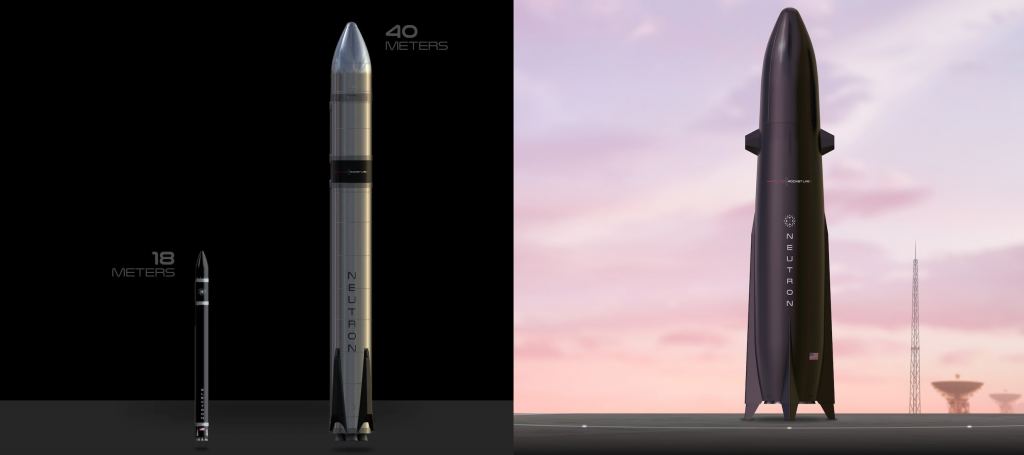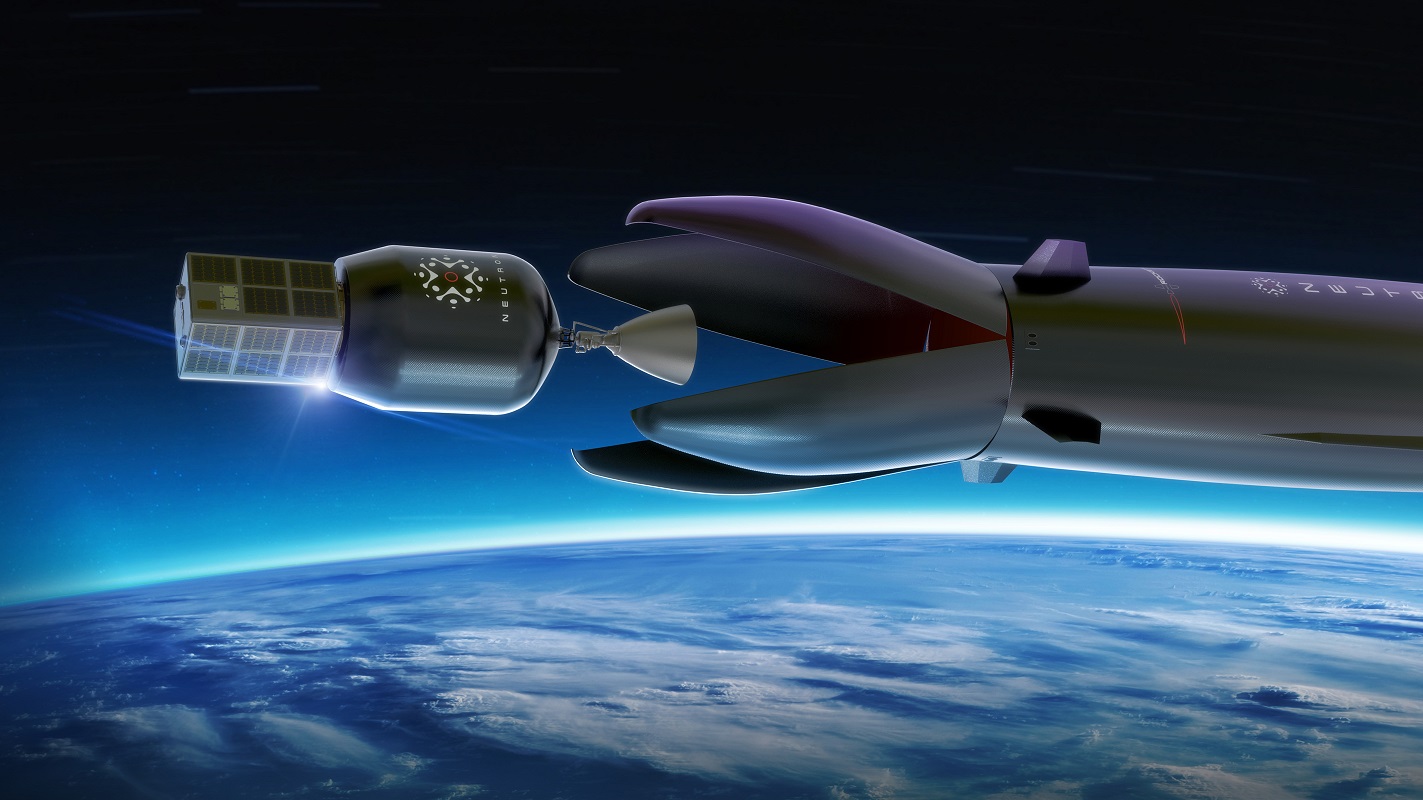On December 2nd, 2021, the commercial space company Rocket Lab unveiled the detailed architecture of their Neutron rocket for the first time. In a live-streamed event, the company showcased all the new elements that will make this “megaconstellation” launcher a serious contender in the coming years. These include updated details about the rocket’s design, materials, propulsion, and reusability architecture.
This new vehicle builds on Rocket Lab’s experience with their Electron rocket, the small-satellite launcher they debuted back in 2017. This two-stage, lightweight carbon composite rocket relied on the first flight-ready electric pump-feed cycle (aka. Rutherford) engine to launch payloads of 300 kg (661 lbs). With 22 launches and 107 satellites deployed to date, the Electron has become the most frequently launched U.S. rocket since 2019.
In the summer and fall of 2020, Rocket Lab began experimenting with reusability by retrieving an Electron first-stage booster with a helicopter and net. Building on this foundation, Rocket Lab began working on a reusable rocket that would feature the same carbon composite skin and updated features. On March 1st, 2021, Rocket Lab CEO Peter Beck provided the first glimpse at their Neutron rocket, an 8-ton payload-class launch vehicle design to service the satellite megaconstellation market.
At the time, Beck presented a design for a 40 meter (130 feet) two-stage reusable rocket that could carry 8,000 kg (17,600 lbs) to Low Earth Orbit (LEO) and 1,500 kg (3,300 lbs) to Mars or Venus. In the live-streamed event that took place last week, Beck provided updated details on the rocket, which included a new shape, a new engine, a new shell, and some rather unorthodox design features. These include:
- The new Archimedes rocket engine designed for reliability and reuse
- Unique captive ‘Hungry Hippo’ fairing design to enable streamlined first stage and fairing reuse
- Carbon composite structure, making Neutron the world’s first carbon composite large launch vehicle
- Designed for ‘return to launch site’ propulsive landing
In addition, Rocket Lab now indicates that while a payload of 8,000 kg to LEO will be standard for the Neutron, the updated design will accommodate a maximum payload of almost twice that to LEO – 15,000 kg (33,070 lbs). As Beck summarized it, the Neutron rocket is what rockets should look like in 2050, with full-reusability and tailor-made for the burgeoning satellite “megaconstellation” market:
“Neutron is not a conventional rocket. It’s a new breed of launch vehicle where reliability, reusability, and cost reduction are hard-baked into the advanced design from day one. Neutron incorporates the best innovations of the past and marries them with cutting-edge technology and materials to deliver a rocket for the future.
“More than 80% of the satellites to be launched in the next decade are expected to be constellations, which have unique deployment needs that Neutron is the first vehicle to address specifically. Like we did with Electron, rather than starting with a traditional rocket design, we focused on our customers’ needs and worked back from there. The result is a rocket that is right-sized for market demand and can launch fast, frequently, and affordably.”
New Shells and Engines
As noted, Rocket Lab pioneered the use of carbon composite shells for orbital rockets with their Electron rocket. The first stage of the Neutron will also have a carbon composite shell, but one made from a new and specially-formulated carbon composite material that is lightweight, strong, and rugged enough to withstand the intense heat and pressure caused by repeated spaceflight and reentry.
The Neutron‘s carbon composite structure will be made using an automated fiber placement system that can build meters of carbon rocket shell in minutes. This will enable rapid manufacturing along with reusability, making Neutron the world’s first large carbon composite reusable launch vehicle. The new Archimedes engine, designed and manufactured in-house by Rocket Lab, will also enable reuse.
The Archimedes is a reusable liquid oxygen (LOX) and a methane gas generator cycle engine, which can generate 1 meganewton of thrust and 320 seconds of specific impulse (ISP). Thanks to Neutron‘s lightweight nature, the engine design is less complex and requires less thrust when compared to conventional rocket engines. This allows for a more rapid development process that enables cost-effective and rapid production.

Seven of these engines will propel the first stage of the Neutron, while a single vacuum-optimized Archimedes engine will power the second stage.
Revolutionary Second Stage and Fairings
Typically, fairings consist of two cone-shaped halves mounted atop a second stage booster that enclose and protect payloads during launch. Once the second stage is deployed and reaches deployment altitude, these fairings will separate to deploy the cargo. Having fulfilled this task, the fairings then fall back to Earth, reentering our atmosphere and splashing down in the ocean.
As SpaceX amply demonstrated between 2018 and 2020, “catching” payload fairings at sea is a challenging process. In fact, the fleet of retrieval ships (Ms. Tree and Ms. Chief) could only catch fairings with their nets less than 20% of the time. By 2021, SpaceX announced that it was abandoning the idea entirely and would resort to fishing them out of the water henceforth.
In contrast, the Neutron rocket features a new design dubbed the “Hungry Hippo,” where the entire second stage and fairings are enveloped in the rocket’s first stage. Rather than falling away, these fairings will open wide to release the second stage and payload before closing again for reentry with the first stage. Once the first stage lands, a new second stage will be integrated, and the rocket will relaunch.
Rocket Lab is currently using an expendable second stage design made of carbon composite that measures 6 meters (20 ft) long and uses a single vacuum-optimized Archimedes engine. This spares the second stage from much of the extreme conditions experienced during launch and reentry, which means they can be made lighter and cheaper (i.e., without the need for heavy shielding).

This design does away with the difficult method of capturing fairings at sea and leads to an overall reduction in costs while increasing launch frequency and flexibility.
Launch and Landing
While Rocket Lab has incorporated aerial retrieval (using a helicopter and net) to make the Electron’s first stage reusable, the entire design and development process of the Neutron rocket has been tailored to ensure reusability. First, the rocket’s shape is tapered and wider at the bottom to provide a stable base for landing (which also removes the need for complex landing systems or legs).
This balanced structure means that the Neutron can stand securely on its legs before and during lift-off and return to the launch site to make a controlled, propulsive landing. This eliminates the need for costly infrastructures like strongbacks and launch towers and ocean-based landing platforms, and transportation back to the launch site. Once again, the purpose is to reduce costs by eliminating expenses while making reusability and repeated launches easier.
In other recent developments, Rocket Lab has finished construction on a new site (Launch Complex Two) at NASA’s Wallops Mid-Atlantic Regional Spaceport facility on the Virginia Coast. This facility is where Rocket Lab hopes to conduct the inaugural launch of the Neutron rocket in 2024. The company is also in the midst of a competitive process to select a rocket production and Archimedes engine test facility on the U.S. East Coast.
With this expansion of Rocket Lab’s fleet and facilities, not to mention the novel ideas informing the design of their Neutron rocket, this New Zealand-based company is likely to be giving other space launch services a run for their money. This includes the “Big Three” – SpaceX, Blue Origin, and Virgin Orbit – but also the many smaller providers that have emerged in recent years and plan to get in on the megaconstellation market.
Further Reading: Rocket Lab

